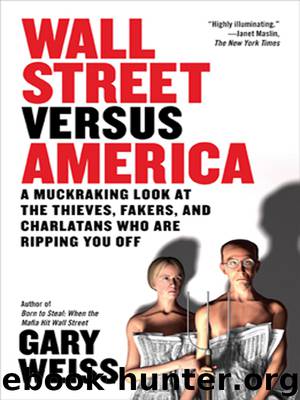Wall Street Versus America by Gary Weiss

Author:Gary Weiss
Language: eng
Format: epub
Publisher: Penguin Publishing Group
Published: 2006-03-31T05:00:00+00:00
Askin’s fund was supposed to be hedged, but wasn’t.
He bought the wrong stuff.
He borrowed too much money.
When things turned bad, investor redemptions made things worse.
When his funds failed, he hurt the market generally.
A number 6 might have been applicable at some point if Askin hadn’t been run off the road by his brokers. The Askin funds, like most hedge funds, had high-water marks that don’t allow a fund manager to take that 20 percent incentive fee until he makes up for losses in previous years. So if a fund manager runs a hedge fund that declines 10 percent one year, he has to push up the portfolio 11.1 percent before drawing a nickel in incentive fees. This sounds terrific, but in reality it sucks.
The high-water mark penalizes managers who engage in volatile investment strategies, in theory. In practice, it is the functional equivalent of handing out cyanide pills to people in depression clinics. Over the years, it has become nothing more than an encouragement for fund managers to close their funds. It’s easy—just a few documents need to be filed with the state corporate-filings office, and of course the fund documents don’t make the suicide process at all difficult.
You can’t blame fund managers for putting an end to their funds when things go bad. After all, nobody wants to work for bupkis. They don’t want to recoup old losses. That’s just a marketing gimmick. They want a fresh start, so they can start charging fees again as if nothing happened. The old investors? Well, they’re accredited and sophisticated, so they’ll understand.
Hedge funds are prone to suicide because they are volatile. The old nursery rhyme sums up their fate: When they are good they are very, very good, and when they are bad they are horrid. Askin did a decent job when the market was doing well. When the market wasn’t doing so well, as happens sometimes with hot markets like mortgage-backed securities, Askin was horrid because he was leveraged to the hilt with the wrong stuff. He wouldn’t have been so horrid if he had been structured like…well, like a hedge fund. An old-fashioned hedged, long-short hedge fund.
The Askin meltdown caused a brief flurry of activity within the self-regulatory pyramid. A task force was organized by the President’s Working Group on Financial Markets. The task force chewed things over for a few months and in September 1994 issued a report. It made a bunch of findings, of which two deserve highlighting: (1) hedge funds “could exacerbate market movements if the funds need to sell to meet margin calls or unwind leveraged positions”; (2) “It may be difficult for banks and broker-dealers to monitor the creditworthiness of hedge funds because they do not typically know the overall positions of hedge funds, which can change rapidly.”
Four years after those words were written, Long-Term Capital Management put the financial system in jeopardy by following fairly closely in the footsteps of Askin and Granite. Rather than repeat the oft-told tale of LTCM, let’s just examine the template at work here.
Download
This site does not store any files on its server. We only index and link to content provided by other sites. Please contact the content providers to delete copyright contents if any and email us, we'll remove relevant links or contents immediately.
The Black Swan by Nassim Nicholas Taleb(6764)
Bad Blood by John Carreyrou(6274)
Pioneering Portfolio Management by David F. Swensen(6079)
Millionaire: The Philanderer, Gambler, and Duelist Who Invented Modern Finance by Janet Gleeson(4094)
Skin in the Game by Nassim Nicholas Taleb(3965)
The Money Culture by Michael Lewis(3846)
Bullshit Jobs by David Graeber(3830)
Skin in the Game: Hidden Asymmetries in Daily Life by Nassim Nicholas Taleb(3723)
The Wisdom of Finance by Mihir Desai(3523)
Blockchain Basics by Daniel Drescher(3329)
Liar's Poker by Michael Lewis(3221)
The Intelligent Investor by Benjamin Graham Jason Zweig(2930)
Hands-On Machine Learning for Algorithmic Trading by Stefan Jansen(2925)
Mastering Bitcoin: Programming the Open Blockchain by Andreas M. Antonopoulos(2891)
Fooled by Randomness: The Hidden Role of Chance in Life and in the Markets by Nassim Nicholas Taleb(2860)
Investing For Dummies by Eric Tyson(2794)
The Power of Broke by Daymond John(2774)
Market Wizards by Jack D. Schwager(2539)
Zero Hour by Harry S. Dent Jr. & Andrew Pancholi(2533)
